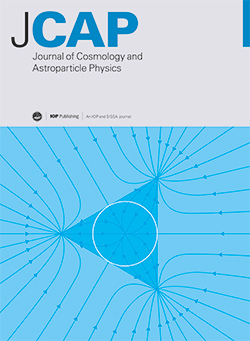快速射电暴透镜效应对扩展轴子结构的约束
IF 5.3
2区 物理与天体物理
Q1 ASTRONOMY & ASTROPHYSICS
Journal of Cosmology and Astroparticle Physics
Pub Date : 2025-04-23
DOI:10.1088/1475-7516/2025/04/067
引用次数: 0
摘要
轴子是一种假想的伪星粒子,一直被认为是很有希望的暗物质(DM)候选者。另一方面,轴子星等扩展紧凑天体在引力和轴子自相互作用的支持下,也可能在早期宇宙中形成,并构成暗物质的一部分。在这项工作中,我们考虑了轴向星对来自遥远来源的电磁信号的透镜作用,以此来约束轴向星的性质和基本轴向参数。考虑到轴子星有限尺寸的影响,我们研究了由引力和轴子-光子相互作用引起的透镜效应。后一种效应与频率有关,在低频段具有相关性,这促使我们使用快速射电暴(FRB)信号作为探测器。我们通过指定基本轴子参数、轴子星径向剖面、驻留在轴子星中的DM比例,并根据通量比和来自透镜的最亮图像之间的时间延迟实施透镜标准,计算出预测的透镜FRB事件数量。假设乐观情况下观测到104个FRB事件,时间分辨率为1微秒,那么在CHIME中没有观测到FRB透镜事件,这使得我们可以探测质量≳ 10-2M⊙的轴子星,对应于轴子质量≲ 10-10 eV,轴子-光子耦合可以忽略不计。假设轴向-光子耦合至少为10-6 GeV-1,那么甚至可以探测到更轻的轴向星,其质量可达∼ 10-3M⊙。我们的结果表明,虽然轴向星的FRB透镜导致的灵敏度与在光学波段运行的传统微透镜搜索具有竞争性,但探测轴向-光子诱导的透镜效应仍然是一个挑战。本文章由计算机程序翻译,如有差异,请以英文原文为准。
Constraints on extended axion structures from the lensing of fast radio bursts
Axions are hypothetical pseudoscalar particles that have been regarded as promising dark matter (DM) candidates. On the other hand, extended compact objects such as axion stars, which are supported by gravity and axion self interactions, may have also been formed in the early Universe and comprise part of DM. In this work, we consider the lensing of electromagnetic signals from distant sources by axion stars, as a way to constrain the properties of axion stars and fundamental axion parameters. Accounting for the effect of the finite size of the axion star, we study the lensing effect induced by gravity, and by axion-photon interactions. The latter effect is frequency dependent, and is relevant in the low frequency band, which motivates the use of fast radio burst (FRB) signals as a probe. We calculate the predicted number of lensed FRB events by specifying the fundamental axion parameters, axion star radial profile, fraction of DM residing in axion stars, and imposing lensing criteria based on the flux ratio and time delay between the brightest images from lensing. Assuming an optimistic case of 104 observed FRB events, and a timing resolution of 1 μs, the lack of observed FRB lensing events in CHIME allows us to probe axion stars with mass ≳ 10-2M⊙, corresponding to axion masses ≲ 10-10 eV and for negligible axion-photon couplings. Even lighter axion stars up to ∼ 10-3M⊙ can be probed, assuming axion-photon couplings of at least 10-6 GeV-1. Our results indicate that while FRB lensing by axion stars lead to sensitivities that are competitive with conventional microlensing searches operating in the optical band, it remains a challenge to probe axion-photon induced lensing effects.
求助全文
通过发布文献求助,成功后即可免费获取论文全文。
去求助
来源期刊

Journal of Cosmology and Astroparticle Physics
地学天文-天文与天体物理
CiteScore
10.20
自引率
23.40%
发文量
632
审稿时长
1 months
期刊介绍:
Journal of Cosmology and Astroparticle Physics (JCAP) encompasses theoretical, observational and experimental areas as well as computation and simulation. The journal covers the latest developments in the theory of all fundamental interactions and their cosmological implications (e.g. M-theory and cosmology, brane cosmology). JCAP''s coverage also includes topics such as formation, dynamics and clustering of galaxies, pre-galactic star formation, x-ray astronomy, radio astronomy, gravitational lensing, active galactic nuclei, intergalactic and interstellar matter.
 求助内容:
求助内容: 应助结果提醒方式:
应助结果提醒方式:


